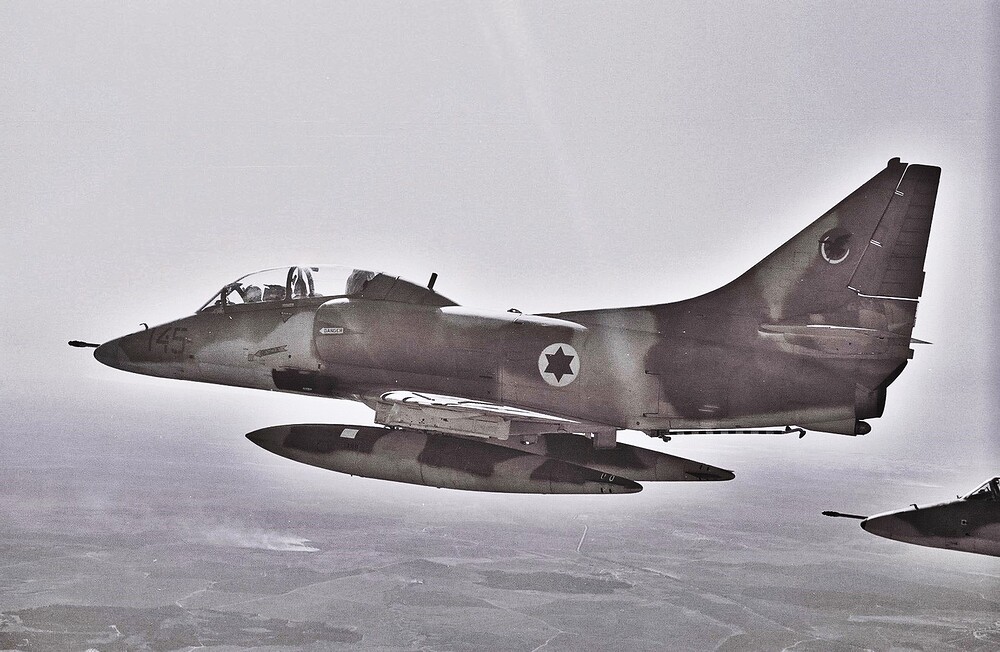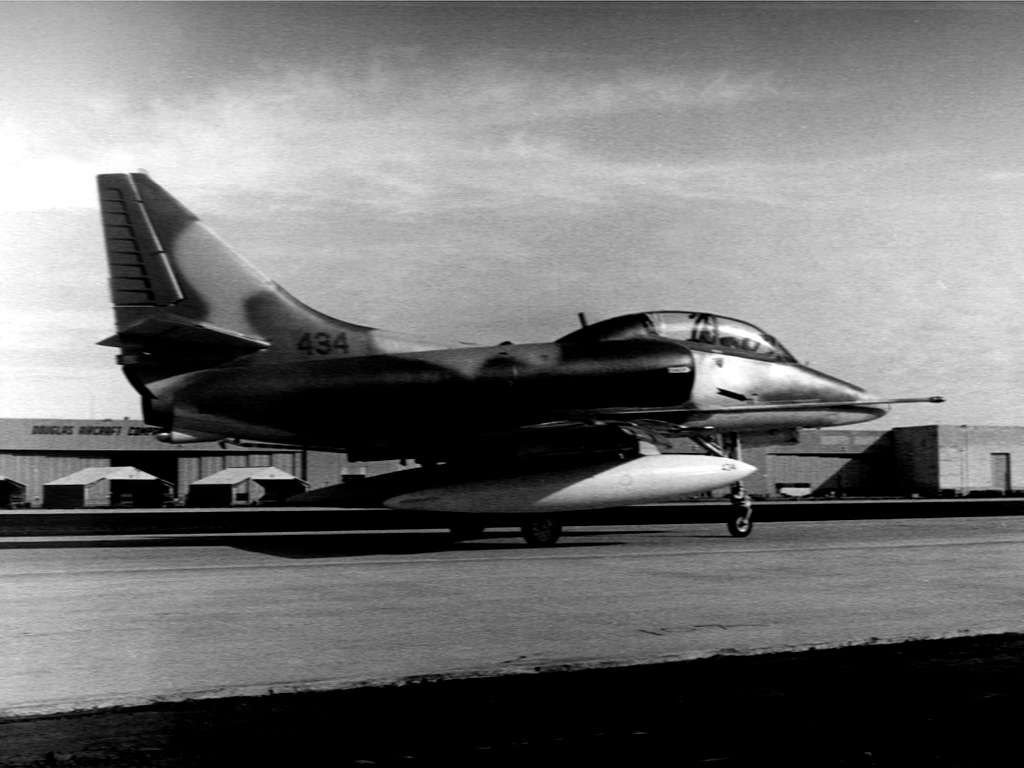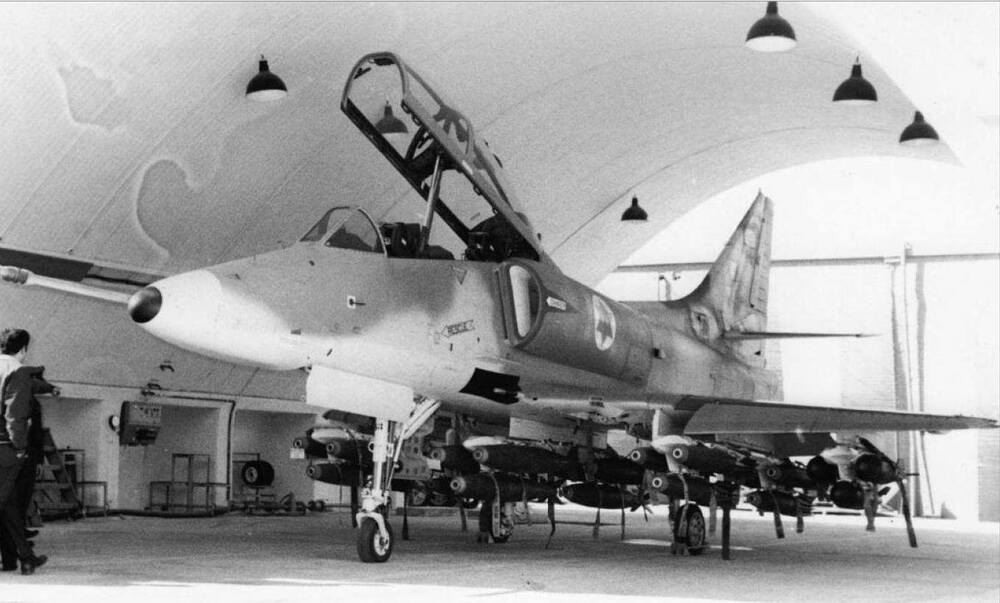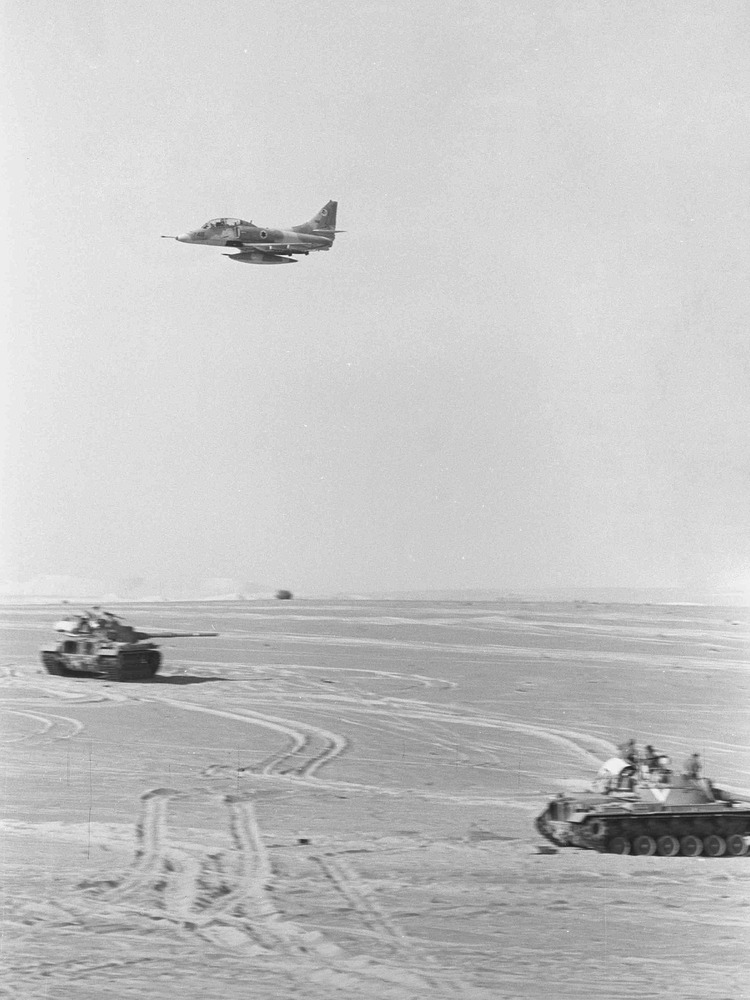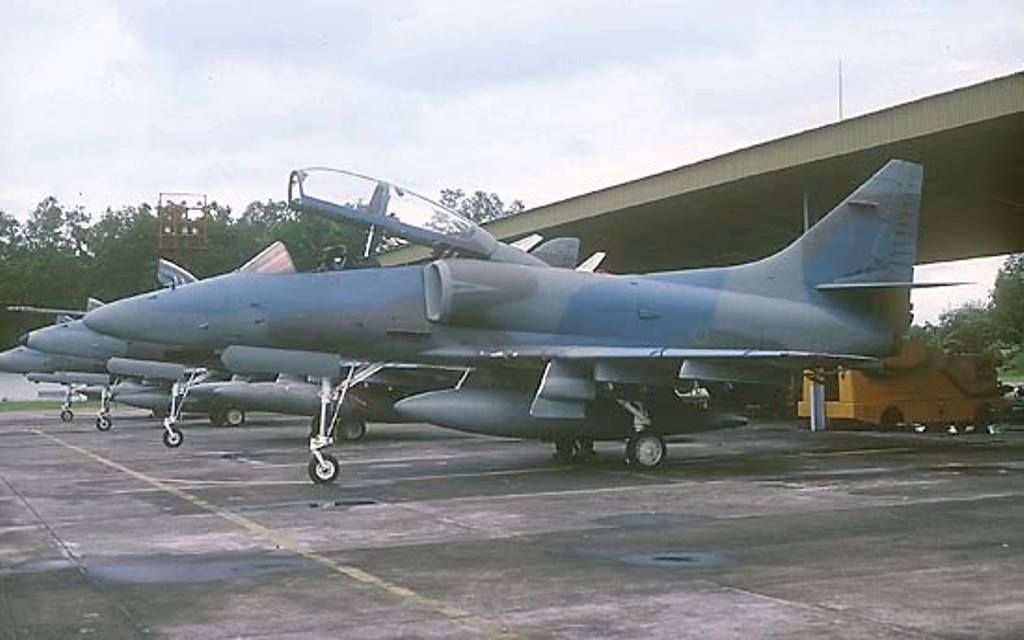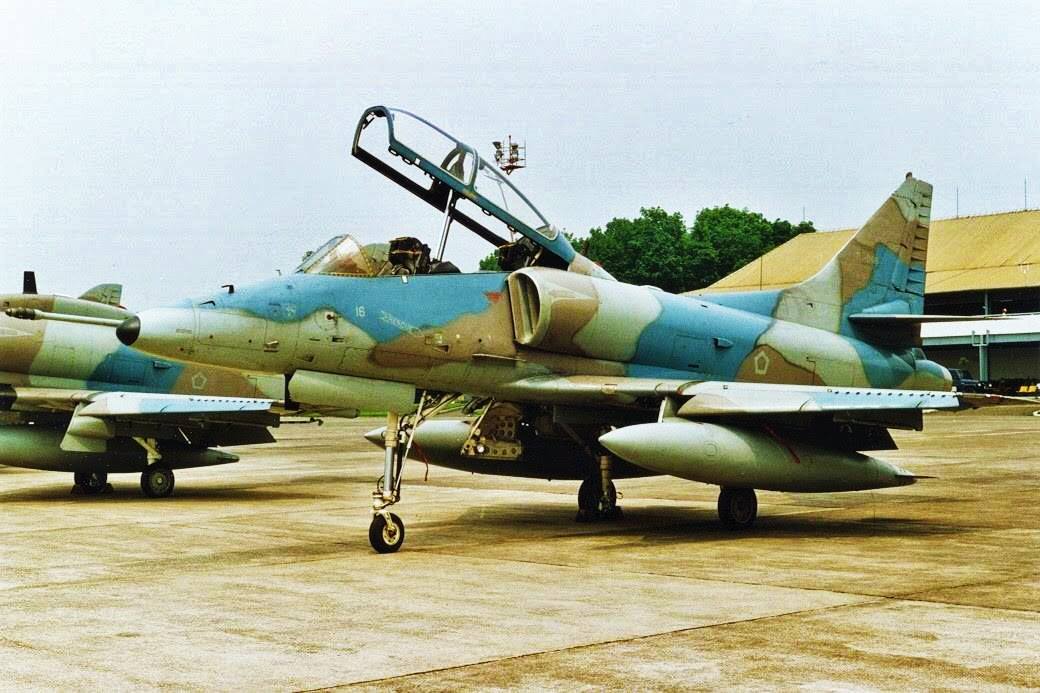- Yes
- No

Introduction
The Douglas TA-4H Skyhawk, was a unique Israeli export model for a 2 seater trainer variant of the Ayit (The general Israeli designation for Skyhawks). Much like other combat capable 2 seater trainers in the Israeli Air Force it had a very active combat history in it’s past and proved to be an important part of the Israeli Air Force’s large A-4 Skyhawk fleet.
Disclaimers
-
I unfortunately was not able to find any source with the specifications of the TA-4H variant specifically. However, since it is based on the TA-4F variant with very minimal changes, I believe it’s specifications reflect the TA-4H’s capabilities well enough, although it is very likely some of the measurements shown might be very slightly off for this model. If anyone can find specifications for this model that would be more accurate please share it in the comments of this post and I will edit it accordingly.
-
In regards to armaments, the options shown in this post reflect what the TA-4H likely had access to based both on photos of what it actually carried and what armaments that the TA-4F could carry were in Israeli inventory. Once again I understand this might not be 100% accurate and I implore whoever has more definitive information to share it in the comments for the sake of accuracy. In the specifications section I specifically comment on which armaments might differ from the TA-4F based on the information available on how the TA-4H differed.
In this photo is one of the first produced TA-4H Skyhawk airframes at the Douglas plant already bearing an Israeli camouflage pattern. Here we can see the two main defining features of this export model, those being the clipped vertical stabilizer design and the brake chute mechanism.
History
During the mid-1960’s Israeli-American relations became a lot warmer, and after many years of the Israeli Air Force relying primarily on France as its main supplier of combat aircraft the Americans were finally willing to discuss selling combat aircraft to the Israeli Air Force in a declaration made in 1965. This was followed by the signing of a contract for production and procurement of an Israeli export model of the A-4 Skyhawk based on the A-4F variant, designated the A-4H, in June 1966. This contract had also included the procurement of a trainer Skyhawk variant, the TA-4H, which was itself a modification of TA-4F designed to include the same changes applied to the A-4H. Specifically, the TA-4H was modified to have reduced capabilities, seemingly not being able to use advanced guided weapons such as the AGM-12 Bullpup, AGM-45 Shrike or AIM-9 Sidewinders. In addition, the vertical stabilizer of the TA-4H had a clipped design (squared tip) also seen on the other specific Israeli Skyhawk variants (A-4H, A-4N) and it had access to a brake chute system installed under the engine exhaust. The TA-4H retained all other capabilities from the TA-4F variant including it’s combat capability. The first TA-4H first flew at the Douglas plant on the 15th of April 1969.
In this photo is TA-4H number 43, one of the first delivered TA-4H airframes, presenting it’s full combat capability to members of parliament on the 25th of December 1969. Of note are the aircraft 's gun armament of 20mm Colt Mk.12 cannons as well as MERs and TERs shown to carry conventional 500lbs Mk.82 bombs, 250lbs Snakeye bombs, and uniquely 100kg IMI G.P bombs only ever seen carried on this Skyhawk variant among two seater versions.
The first 10 examples of the TA-4H were delivered along with the first single seat A-4Hs to the IAF in late 1969. At the time Israel was fighting against Egypt in a prolonged conflict across the Suez Canal that followed 1967’s Six Day War, know as the War of Attrition. The newly arrived A-4H Skyhawks were pressed into combat soon after their arrival, conducting combat strike sorties and even scoring some air to air kills. The two seater TA-4H Skyhawk, despite being designated as a trainer, was fully combat capable and so these two seater airframes were also sent to perform combat sorties, though usually with only one pilot. It is also noted by some sources that the TA-4H Skyhawks inherited the responsibility of using the Yabelet ECM pod during this war, previously used by the IAF’s Vautour bombers which were being phased out of service.
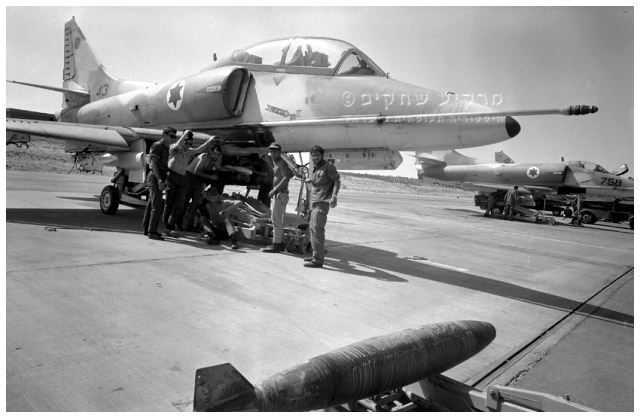
TA-4H number 43 being armed during an exercise. on the 13th of October 1973, During an artillery ranging mission in the Yom Kippur War, this TA-4H was shot down by an Egyptian SA-2 missile. Yehuda Sheffer who was an intelligence officer flying in the back seat survived while the pilot Ran Ofri did not.
Following the War of Attrition the IAF’s Skyhawk fleet went through several changes leading up the 1973 Yom Kippur War. The IAF acquired several new Skyhawks including the last 15 TA-4Hs left on order for a total of 25 TA-4Hs that had served in the IAF. At the same time the IAF had also acquired a few two seater Skyhawks of different variants including TA-4Fs and TA-4Js. At this point, due to the increasingly growing number of Skyhawks in IAF service, the numbering system for the aircraft was revised with templated prefixes meant to indicate aircraft variant and sometimes also the operating squadron. The TA-4Hs of the 102nd squadron received the 7XX template and those of the 109th squadron received the 1XX template. These prefix templates are very useful for distinguishing 2 seater Skyhawk variants as there were very few external differences between them. Additionally, it’s worth mentioning that in this interwar period the IAF began to modify its single seat Skyhawks’ gun armaments, switching the 20mm Colt Mk.12s with 30mm DEFA 553s, however none of the two seater variants received this modification, retaining the 20mm cannons.
Shown here is a TA-4H Skyhawk flying over a couple of Israeli tanks during a combat sortie in the 1973 Yom Kippur War.
During the October 1973 Yom Kippur War TA-4H Skyhawks saw combat once again. While they performed their duty admirably, the TA-4Hs and Skyhawks in general were far less fortunate in this conflict, with many of them being shot down. Of the TA-4Hs specifically 2 airframes were lost, with number 46 being downed on the 8th of October and number 43 downed on the 13th of October. During and immediately after this war Israeli Skyhawks began receiving the extended fiberglass tail pipe modification, intended to extended the heat signature of the aircraft further back to increase survivability. Most of The TA-4Hs, like all other Skyhawks, received this modified tail pipe at that point. Additionally at the time, as a part of the lessons of the war, both the A-4Hs and TA-4Hs were modified to include the same countermeasure dispensing system that was found on the rest of the Skyhawks in service consisting of a pair of AN/ALE-29A countermeasure blocks. After the Yom Kippur War the Skyhawks once again went through a restructuring of their numbering with all of the TA-4Hs getting the 5XX template.
This photo, which is useful for comparing Skyhawk variants and showing just how difficult they are to differ externally, shows a TA-4H (number 547) Flying next to a TA-4J (number 725). At this point both aircraft were modified to a very similar standard which makes differentiating Impossible, as TA-4J 725 was among the last TA-4Js to be delivered to Israel which are sometimes unofficially called TA-4J(H)s as they also had the squared vertical stabilizer design. This means that the only way to know the variants here is based on the identification number.
During the following years in service the TA-4Hs were no longer used for combat, with pilot training becoming their sole purpose. To that end, with combat no longer on the table, some of the TA-4Hs as well as some TA-4Js ended up losing their cannon armament altogether. Additionally at the time the Israeli Air Force ordered additional TA-4J Skyhawks supplementing this role, some of which unofficially designated as TA-4J(H)s had the same vertical stabilizer design as the TA-4H. In 1979 two TA-4Hs (number 540 and number 541) were sold to Indonesia along with several A-4Es who became the only other country to operate the TA-4H.
The two TA-4H that were sold to Indonesia, 540 (1st photo) and 541 (2nd photo), in the colors of the Indonesian Air Force. Note that TA-4H number 540 had never received an extended tail pipe like number 541 has. Also note that both aircraft lacked cannons in Indonesian Air Force service.
In 2004 The TA-4Hs, as well as the TA-4Js, TA-4J(H)s and A-4Ns, were refurbished under a program called “Ayit Meshupar” (Improved Ayit). This refurbishment saw the aircraft being modernized with a new HUD made by VECTOP, an improved GPS based navigation system and a modern mission and fire control computer. The TA-4Hs continued their service as trainers with these modernizations until the 13th of December 2015 when all Skyhawks that were still in service were retired. Today some TA-4Hs still remain in the Israeli Air Force Museum grounds and some Israeli Air Force bases, however they are seemingly not in a condition fit for display.
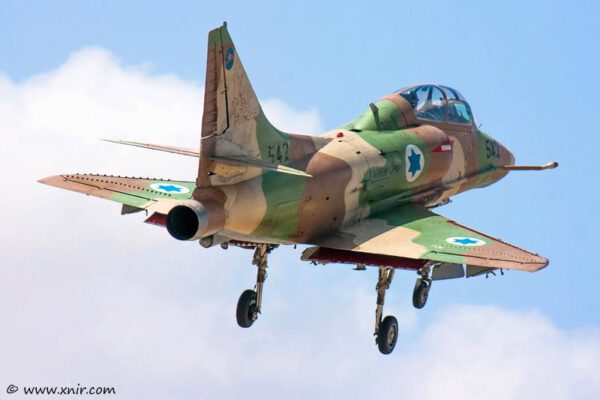
In this photo is TA-4H 542 after it had been upgraded to Ayit Meshupar standard.
Technical information
To sum up some of the technical details, the main differences between the TA-4H and TA-4F it was based on at the time of delivery in 1969 are as follows:
- Reduced weapon compatibility capability (No access to AGMs)
- Different vertical stabilizer design, the TA-4H has squared tip while the TA-4F/J have a rounded one
- Addition of a brake chute mechanism below the engine exhaust
After The Yom Kippur War most of the TA-4Hs received AN/ALE-29A countermeasure blocks and the extended fiberglass tail pipe.
In 2004 The TA-4Hs were modified to “Ayit Meshupar” standard receiving a modern HUD, GPS based navigation system and a modern mission and fire control computer.
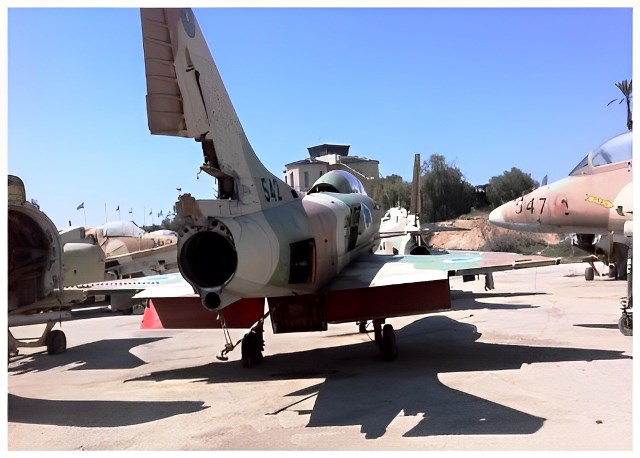
TA-4H number 542 in storage at the Israeli Air Force museum ground. As can be clearly seen here it’s in no condition to be displayed.
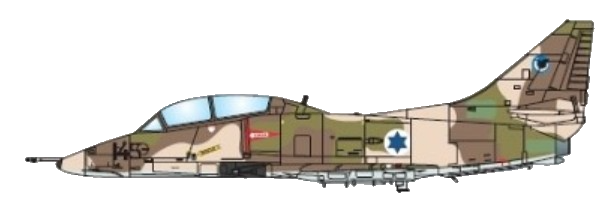
Specifications
Type: Tandem Seat Trainer/Attack Aircraft
Country of origin: USA
Wing span: 8.38 meters
Length: 12.98 meters (not accounting for tail pipe)
Height: 4.76 meters
Powerplant: Pratt and Whitney J-52-P-8A rated at 4,218 kgf
Max speed: 1,085 km/h
Max altitude: 13,200 meters
Range: 2494 km
Weight: Empty - 4,993 kg, Fully loaded - 11,113 kg
Armaments: 2x20mm Colt Mk.12 cannons (100 round per gun for a total of 200), Mk.80 series bombs (including ones with Snakeye kits), IMI G.P bombs (only 100kg shown properly), M117 bombs, FFAR Might Mouse rockets, Zuni rockets, 20mm Mark 11 mod 5 cannon-pods, Mk.77 Incendiary bombs.
Avionics:
- Refueling Probe
- APG-53A Radar
- ASN-41 Nav computer
- ARC-51A UHF Comm
- ARR-69 UHF AUX Rec
- APX-64 Radar IFF
- APN-153 Doppler Navigation Radar
- TACAN ARN-52
- ARA-50 ADF (UHF)
- ARN-141 Radar Altimeter
- AN/AJB-3A LABS and CP-741 Weapon Delivery Systems (CCRP) (Unknown if it was actually available to this variant, it was available to the TA-4F)
- Brake Chute
- A pair of AN/ALE-29A countermeasure blocks housing together 60 charges (Available only after the Yom Kippur War along with the installation of the extended tail pipe)
- Provisions for JATO (Jet Assisted Takeoff) boosters
Sources
Spoiler
https://www.isradecal.com/product-page/iaf-a-4-ayit-in-service-with-109-110-squadrons
Israeli A-4 Skyhawk Units in Combat (Combat Aircraft, 81): Aloni, Shlomo, Laurier, Jim: 9781846034305: Amazon.com: Books
סקייהוק - מרקיע שחקים
IDF/AF A-4 Skyhawk Facebook group
מטוסי חיל האויר מהטייגר מות' עד הסופה
Air War on the Edge: A History of the Israel Air Force and It's Aircraft Since 1947: Norton, Bill: 9781857800883: Amazon.com: Books
McDonnell Douglas - TA-4F & TA-4J Two-Seater Skyhawks - REPORT MDC-J4176 May 1st 1972
Standard Aircraft Characteristics Navy Model TA-4F Aircraft NAVAIR 00-110AA4-7
Supplement to NATOPS Flight Manual Navy Model A-4E/F International Model A-4K aircraft NAVAIR 01-40AVK-1
